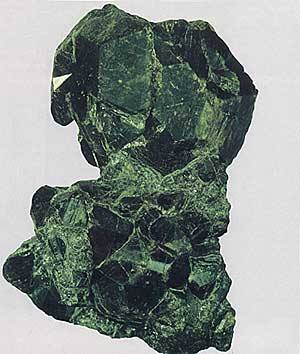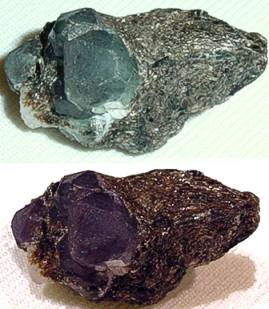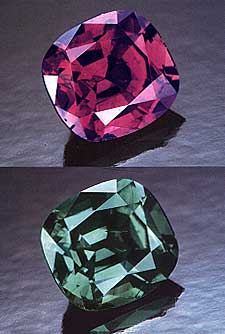
|
|

I
took over this e-zine when Gail, its originator was unable to continue it. With
Gail's permission, I have added her original Rock's of the Week so that everyone
can find the information readily. Please feel free to visit Gail's web site at http://www.davesrockshop.com. |
|
Alexandrite
June Birthstone

Raw alexandrite from the Urals
|
|
Scientific:
Alexandrite owes its name to the fact that it was discovered in the Urals in 1830, on the day that Prince Alexander of Russia's coming of age (turning 21).
Alexandrite is a very rare mineral variety of chrysoberyl, which occurs in granitic pegmatites and mica
schists. Small-scale replacement in chrysoberyl of alumina by chromic oxide results in the formation of the variety alexandrite and is responsible for alexandrite's characteristic green to red color change. Poets have spoken of alexandrite as "an emerald by day and a ruby by night."
It is green in daylight and red in artificial incandescent light. It can be almost emerald green, but is more often yellowish or brownish green. It's main characteristic is the ability to change color if exposed to a light source rich in red rays; by candlelight or tungsten light, it turns red or reddish. This unusual phenomenon is what distinguishes it from other green chrysoberyl. This pronounced color change from green to red is highly prized and, as always, the exact tone of the color, or colors, is important. The ideal color change is brilliant green turning into fiery red, although dull green turning reddish or slightly turbid blood red is more common. This changing color is best seen in thick stones. Alexandrite from the Urals is blue-green in daylight and bright purplish-red under tungsten light. The stone from Ceylon is olive-green to brown in the day light and red under artificial light.
Given the rarity of alexandrite, even stones with a number of inclusions are cut. Alexandrite displaying the cat's eye effect is a great rarity.
The changing color is an unmistakable characteristic. However, recently, small quantities of green or bluish colored grossular garnet that turn red like alexandrite have been found in South Africa. To distinguish between the two, it is useful to look for signs of birefringence, as garnet, unlike alexandrite, is singly refractive. (Birefringence is the ability of certain crystals to split incident light into two rays.)
Alexandrite is so rare that very few people have actually seen one; and perhaps for this reason, the name is applied to other, mainly synthetic stones, not remotely like it (usually violet colored synthetic corundum's).
Care must be taken when working with it, as it is sensitive to knocks and color changes are possible with exposure to great heat. High quality alexandrite is one of the most expensive of all gemstones.
The deposits in the Urals are all worked out. Today it is mined in Sri Lanka, Zimbabwe, Brazil, Burma, Madagascar, and Tanzania. The largest stone, 1876 ct, was found in Sri Lanka. The largest cut alexandrite weighs 66 ct; it is in the Smithsonian Institute in Washington, D.C.
Alexandrite is used only in jewelry. It is so rare that anything over 5 carats is considered big!
Variety of: Chrysoberyl
Chemical Composition: BeAl2O4 Fe,Ti beryllium aluminum oxide
Hardness: 8.5 |

Alexandrite from Russia in
natural and incandescent light
|
History:
Alexandrite was a favorite gemstone with Russian aristocrats. The red and green colors of the gem match the czarist military colors.
Alexandrite can be found in jewels of the period, as it was well loved by the Russian master jewelers. Master gemologist George Kunz of Tiffany was a fan of alexandrite and the company produced many rings featuring fine alexandrite in the late nineteenth and early twentieth century, including some set in platinum from the twenties. Some Victorian jewelry from England features sets of small
alexandrites.
Lore:
Because of the luck of discovering the gem on the Czar's birthday, it is considered a good luck amulet. |

This 1.29-carat Russian alexandrite displays the change-of-color that has made stones from this deposit so famous. From the Mary Murphy collection.
Photos ©1988 Tino Hammid, Los Angeles
|
Metaphysical:
Alexandrite is said to help balance one's emotional state, to provide confidence, to increase self-esteem and to help bring about change. It is also said to bring happiness and success, and to intensify feelings of love and sensuality.
Alexandrite is an emblem of loyal regard. Dreams of alexandrites are said to symbolize struggle and progress.
The alexandrite is regarded as a harbinger of good luck. It is used to enhance luck and love into ones life.
It is a crystal often used to connect one with the very origin of being itself, and to help in spiritual growth of wholeness of self. It has been used as a stone of manifestation and good fortune, joy, and creativity.
Helps to align mental and emotional body and aids in spiritual transformation and regeneration. This stone reflects one's highest potential, raises self-esteem, and brings oneness with life. It aids internal and external regeneration.
Alexandrite is so special; it bestows both an uplifting and ennobling energy. In it's highest aspect, alexandrite symbolizes freedom, joy, and regeneration. |
|






